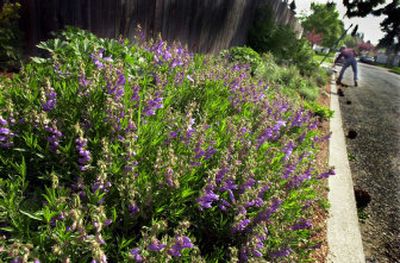These plants handle thirst

Christi Bristow has a major challenge on her hands, because she has taken on a gardening project that would be daunting for the most experienced Inland Northwest gardener. Bristow, however, is a relative new transplant from Western Washington, so it may not seem as daunting to her.
At her church, Country Homes Christian, the church sign sits in a patch of dirt in the middle of a parking lot close to the street. It is at least 70 feet from the nearest sprinkler head and even farther from the closest faucet. Occasionally deer wander through.
Here’s the thing: Christi wants to landscape the dry, barren spot around the sign.
Fortunately it’s only about 12-by-30-feet square and gets a little shade in the late afternoon, and she is willing to water it every 10 days or so. This is the perfect opportunity to bring on the truly drought-tolerant plants.
Here’s a list of what I’d recommend to Christi and anyone else with a dry, barren spot in their yard:
Ground covers
Kinnikinnick – native evergreen with small shiny green leaves, tiny pink flowers that form a dense, 4-inch tall mat. Moderate grower.
Hardy ice plant – flat to the ground, succulent ground cover that blooms in June in pink, purple, yellow and shell pink. Fast grower.
Creeping thyme – several varieties that vary in height from less than an inch to 4 inches. Some varieties have pink flowers in the late spring.
Middle-height plants (1 to 2 feet tall)
Penstemon – another native plant with a number of varieties that bloom in reds, pinks, blues, purples, whites and yellow. You could make a whole garden of these.
Hummingbird trumpet or Zauschneria – Green-gray leaves and orange red flowers from mid-July to frost. Pair this one with the red flowering pinleaf penstemon for red from early June to frost. Hummingbirds love it.
Walker’s low catmint – crinkled blue foliage with lavender-blue flowers in late June through July. Can be cut back and will rebloom lightly later in the summer.
Yarrows – choose the yellow and gold varieties, as they tend not to reseed. Great flat-topped flowers that hold their color and can be dried to add color to winter decorations.
Santolina – mounding aromatic gray-green foliage and yellow button-shaped flowers. Grows in a fairly tight clump.
Lavenders – mounding gray green foliage topped with very fragrant flowers in July. Colors can range from purple through the blues to pink. Range in height from 18 to 40 inches, depending on the variety.
Blooms hold their color for weeks. Make sure to check if it’s hardy in our area.
Background or taller accent plants (3 to 4 feet tall)
Russian sage – stately, upright plant with light gray-green foliage and medium blue flowers that bloom in early August and last several weeks.
Feather reed grass – Upright ornamental grasses that have a tan seed head in late summer and turn tanny gold in the fall. Karl Forester is all green; Overdam, Glacier and Avalanche have variegated white and green blades. Ornamental grasses catch light and the wind, creating movement in the flowerbed. Grasses also add fall and winter interest to the garden when everything else is gone.
Hardy yuccas – bold strap-shaped gray-green leaves that form a mound. Sends up a 5- to 6-foot creamy white bloom in July.
Many of these plants are readily available at area nurseries or by mail order.